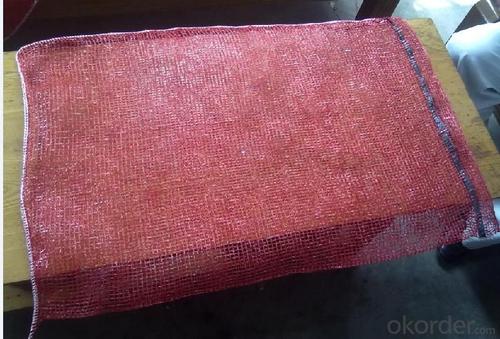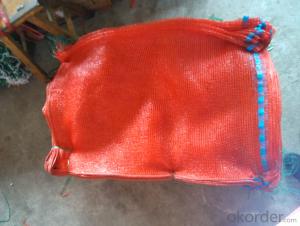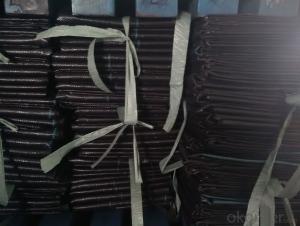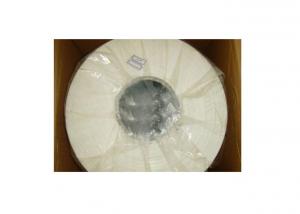Vegetable Mesh Bag 25G Packing Plastic Bags
- Loading Port:
- Shanghai
- Payment Terms:
- TT OR LC
- Min Order Qty:
- 10000 m²
- Supply Capability:
- 1000000 m²/month
OKorder Service Pledge
OKorder Financial Service
You Might Also Like
Product Name of Vegetable Mesh Bag 25G Packing Plastic Bags :
PE Mesh Bag VIOLET
Loading Port: Shanghai port, China
Min.order quantity: 1*20GP
Supply Capability: 20*40HC per month
Payment Terms: TT or LC
Introduction of Vegetable Mesh Bag 25G Packing Plastic Bags :
This products is made by HDPE (High-Density Polyethylene) or PP (Polypropylene), it is used for packing olive, onions, potatoes, and so on.
Specification of Vegetable Mesh Bag 25G Packing Plastic Bags :
30x50cm, 40x60cm, 42x70cm, 50x80cm, 55x78cm, 55x85cm, 57x86cm, 60x90cm, etc.
Width and length are as customers’ request.
Color: red, green, yellow, white, pink, orange, purple, as per your requirements
Top: Hemmed or locked, with drawstring or without, handle is available
Bottom: Single fold or double fold. Single stitch or double stitch
Printing: on one side or both sides, in one color or multi-colors
Application of Vegetable Mesh Bag 25G Packing Plastic Bags :
It can be used packing onions, potatoes, apples, orange and other vegetables or fruits. It can hold heavy enough produces


FAQ of Vegetable Mesh Bag 25G Packing Plastic Bags:
Q: How to guarantee the quality of the products?
A:We have established the international advanced quality management system,every link from raw material to final product we have strict quality test;We resolutely put an end to unqualified products flowing into the market. At the same time, we will provide necessary follow-up service assurance.
Q: How long can we receive the product after purchase?
A:In the purchase of product within three working days, We will arrange the factory delivery as soon as possible. The pecific time of receiving is related to the state and position of customers.Commonly 30 to 35 working days can be served.
Q: HOW TO GET A SAMPLE?
A: FREE samples for Agricultural Patato Mesh Bag HDPE Material 25g are available for your checking and testing. And to get free samples, you need to send us you detailed receiving address (including post code) and your DHL/FedEx/UPS account for collecting samples, courier cost will be paid in your side.
- Q: Can agricultural plastic products be used for irrigation pipe fittings?
- Yes, agricultural plastic products can be used for irrigation pipe fittings. Agricultural plastic products such as PVC or polyethylene pipes and fittings are commonly used for irrigation systems due to their durability, flexibility, and resistance to chemicals. These fittings are designed specifically for irrigation purposes and are compatible with various pipe sizes, allowing for efficient water distribution in agricultural fields.
- Q: What types of plants are commonly used as ground cover?
- Some common types of plants used as ground cover include creeping thyme, vinca minor, English ivy, pachysandra, and creeping juniper.
- Q: Can agricultural plastic products be reused?
- Yes, agricultural plastic products can be reused.
- Q: How do you control weeds in ground cover beds?
- There are several effective methods to control weeds in ground cover beds. One approach is to manually remove weeds by hand, ensuring to pull them out from their roots to prevent regrowth. Another option is to lay down a thick layer of mulch to suppress weed growth and also retain moisture in the soil. Additionally, using weed barrier fabric or landscape fabric beneath the ground cover can prevent weeds from emerging. Regularly inspecting the beds and promptly removing any new weeds that appear is crucial to maintaining weed control.
- Q: How do plastic plant pots contribute to efficient nursery management?
- Plastic plant pots contribute to efficient nursery management by offering several advantages. Firstly, they are lightweight and easy to handle, making it convenient to transport and rearrange plants within the nursery. Secondly, plastic pots have excellent durability and longevity, reducing the need for frequent replacements. This saves both time and money for the nursery. Additionally, plastic pots provide better insulation, protecting plant roots from extreme temperatures and reducing the risk of damage. Moreover, these pots have excellent drainage properties, ensuring proper water flow and preventing waterlogging, which is crucial for plant health. Lastly, plastic pots are also cost-effective compared to other materials, allowing nurseries to allocate their resources efficiently. Overall, plastic plant pots contribute to efficient nursery management by providing convenience, durability, insulation, proper drainage, and cost-effectiveness.
- Q: How are plastic honeycomb panels used for hive ventilation?
- Plastic honeycomb panels are used for hive ventilation by being installed on the sides or top of the beehive. The honeycomb structure allows air to flow through the panels, ensuring proper ventilation within the hive. This helps regulate the temperature and humidity levels, creating a healthier environment for the bees and promoting their overall well-being.
- Q: This question asks about the manufacturing process of agricultural plastic products.
- <p>Agricultural plastic products are made through a series of processes that involve polymer production, shaping, and curing. First, raw polymer materials like polyethylene or polypropylene are melted in an extruder. The molten polymer is then shaped into various forms such as films, sheets, or pipes through processes like extrusion, blow molding, or injection molding. These shaped products are then cooled and solidified to maintain their form. Some products may require additional steps like cutting, printing, or coating. Finally, the finished products are packaged and shipped for use in agriculture, such as for mulching, greenhouse coverings, or irrigation systems.</p>
- Q: How can one manufacture biodegradable plastic bags? What would be the cost?
- If I comprehend it wisely they incorporate a potato starch content. To sell plastic baggage that are no longer biodegradable and having marketed them as such ought to convey approximately the employer being prosecuted.
- Q: Are nursery trays suitable for starting climbing vines?
- Yes, nursery trays can be suitable for starting climbing vines. Nursery trays provide a controlled environment for seedlings to develop strong root systems, which is essential for the growth of climbing vines. Additionally, the individual compartments in nursery trays help prevent tangling and promote vertical growth, which is beneficial for climbing plants. However, it is important to ensure that the trays have sufficient depth and space for the vine's root growth, and that the trays are well-drained to prevent waterlogging.
- Q: Can ground cover be used in high foot traffic areas?
- Yes, ground cover can be used in high foot traffic areas. However, it is important to choose the appropriate type of ground cover that is durable and resilient to withstand heavy use. Options such as grass varieties like Bermuda or Zoysia, as well as low-growing plants like creeping thyme or creeping juniper, can be suitable for high foot traffic areas. Regular maintenance and occasional reseeding may be necessary to ensure the ground cover remains healthy and visually appealing.
Send your message to us
Vegetable Mesh Bag 25G Packing Plastic Bags
- Loading Port:
- Shanghai
- Payment Terms:
- TT OR LC
- Min Order Qty:
- 10000 m²
- Supply Capability:
- 1000000 m²/month
OKorder Service Pledge
OKorder Financial Service
Similar products
Hot products
Hot Searches
Related keywords


































